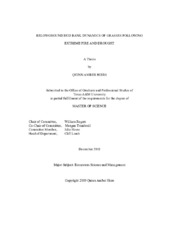| dc.description.abstract | With the removal of fire and increased grazing pressures in savanna ecosystems worldwide, graminoid abundances have decreased while invasive woody shrubs densities have increased. This has contributed to numerous deleterious ecological and economic consequences for vast semiarid savanna landscapes. Despite tremendous resilience in the majority of resprouting woody plants, previous studies have shown that the use of high-intensity fires during drought can cause woody shrub mortality. However, it is not well-known whether high-intensity fires conducted in during drought are equally deleterious for native grasses. The objectives of this study were to assess the persistence and recovery of native grasses following varying fire intensities to identify how fire intensity impacts bud bank dynamics and evaluate the production of water-repellent soil layers potentially induced by different fire treatments. We established our study in a semiarid Texas savanna rangeland and our treatments consisted of 1) control, 2) low-intensity burn, and 3) high-intensity burn plots. Tillers were collected from two abundant, physiologically-distinct grass species, Nassella leucotricha and Hilaria belangeri, over the course of a year, and the associated belowground buds were counted and their activity classified as either active, dormant, or dead. Soil cores were taken to assess soil water repellency before and after burning.
We found that our treatments did not produce a hydrophobic soil layer. Dead buds significantly increased and bud activity decreased in the high-intensity fire treatment within 24hr post-treatment for both species. Similarly, low-intensity treatment also resulted in an immediate decrease in bud activity for both species, and an increase of dead buds for H. belangeri. Despite bud death, N. leucotricha individuals resprouted in the high-intensity treatment but not all of H. belangeri individuals did. Over 8 months, we found that N. leucotricha bud numbers and activity in the high-intensity treatment were equal to the control by the end of our study. H. belangeri bud numbers and activity in the high-intensity treatment were significantly lower than the control by the end of the study. Understanding how fire intensity impacts the bud banks of grasses will allow better predictions of grass response to various management tools, such as high-intensity fires. | en |


